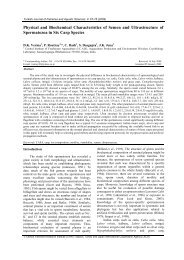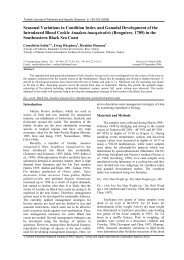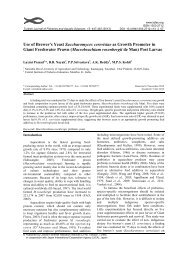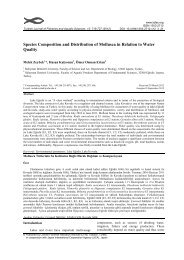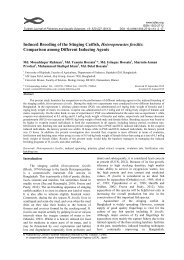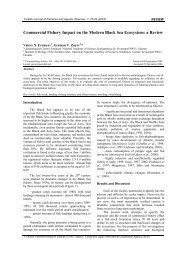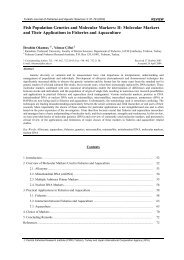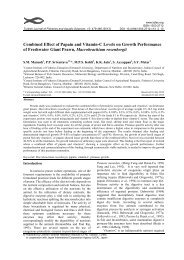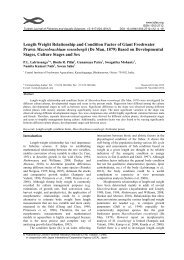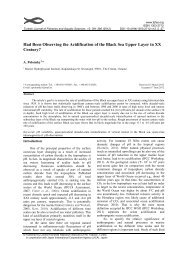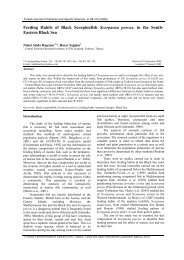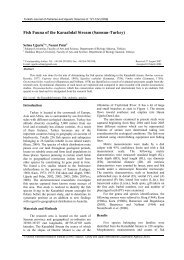The Plankton and Fishes of a Tropical Creek in South-Western Nigeria
The Plankton and Fishes of a Tropical Creek in South-Western Nigeria
The Plankton and Fishes of a Tropical Creek in South-Western Nigeria
You also want an ePaper? Increase the reach of your titles
YUMPU automatically turns print PDFs into web optimized ePapers that Google loves.
Turkish Journal <strong>of</strong> Fisheries <strong>and</strong> Aquatic Sciences 7: 105-113 (2007)<strong>The</strong> <strong>Plankton</strong> <strong>and</strong> <strong>Fishes</strong> <strong>of</strong> a <strong>Tropical</strong> <strong>Creek</strong> <strong>in</strong> <strong>South</strong>-<strong>Western</strong> <strong>Nigeria</strong>B.E. Emmanuel 1 , I.C. Onyema 1, *1Department <strong>of</strong> Mar<strong>in</strong>e Sciences, University <strong>of</strong> Lagos, Akoka, Lagos, <strong>Nigeria</strong>.* Correspond<strong>in</strong>g Author: Tel.: +234 08060442323; Fax: -;E-mail: iconyema@yahoo.com.auAbstractReceived 13 April 2006Accepted 19 June 2007Investigations on the physico-chemical characteristics, phytoplankton, zooplankton, f<strong>in</strong>fish <strong>and</strong> shell fish component <strong>of</strong>an estuar<strong>in</strong>e creek <strong>in</strong> <strong>South</strong>-western <strong>Nigeria</strong> was carried out for one year between March, 2003 <strong>and</strong> February, 2004. <strong>The</strong>study showed notable seasonal variation <strong>in</strong> the components <strong>in</strong>vestigated. Sal<strong>in</strong>ity regime seemed a major determ<strong>in</strong>ant <strong>of</strong> thecomposition, abundance <strong>and</strong> seasonal variation <strong>of</strong> encountered creek biota. Ra<strong>in</strong> events associated with reduc<strong>in</strong>g sal<strong>in</strong>ities<strong>and</strong> tidal lagoonal <strong>in</strong>flow associated with <strong>in</strong>creas<strong>in</strong>g sal<strong>in</strong>ities may be key hydro-meteorological forc<strong>in</strong>g operat<strong>in</strong>g <strong>in</strong> thecreek. Dur<strong>in</strong>g the study, 82 species <strong>of</strong> phytoplankton, 18 species <strong>of</strong> zooplankton, 17 species for f<strong>in</strong>fish, 4 species <strong>of</strong> shell fish<strong>and</strong> 7 categories <strong>of</strong> juvenile forms were recorded. In all, freshwater, estuar<strong>in</strong>e <strong>and</strong> mar<strong>in</strong>e species <strong>of</strong> all trophic levels<strong>in</strong>vestigated were recorded <strong>in</strong> the creek at one time or the other dur<strong>in</strong>g the survey. <strong>The</strong> array <strong>of</strong> juvenile forms recordedprobably po<strong>in</strong>ts to the suitability <strong>of</strong> the creeks characteristics to serve as breed<strong>in</strong>g ground <strong>and</strong> place <strong>of</strong> refuge for diverseaquatic species.Key Words: Estuar<strong>in</strong>e, f<strong>in</strong> fish, shell fish, phytoplankton, zooplankton, physico-chemical.Introduction<strong>Creek</strong>s <strong>and</strong> lagoons are common hydrologicalfeatures <strong>of</strong> <strong>South</strong>-<strong>Western</strong> <strong>Nigeria</strong> <strong>and</strong> form part <strong>of</strong>the numerous ecological niches associated with the<strong>Nigeria</strong>n coastal environment (Chukwu <strong>and</strong>Nwankwo, 2004). <strong>Creek</strong>s <strong>in</strong> this region are usuallyconnected to lagoons <strong>and</strong> f<strong>in</strong>d their way to the sea viathe Lagos habour all year round (Nwankwo <strong>and</strong>Ak<strong>in</strong>soji, 1992). Over the years, tidal creekecosystems, particularly <strong>in</strong> the <strong>in</strong>dustrialized areas <strong>of</strong>Lagos metropolis, are endur<strong>in</strong>g stress-<strong>in</strong>ducedchanges as a result <strong>of</strong> steadily yet <strong>in</strong>creas<strong>in</strong>g humanactivities <strong>and</strong> associated effects (Onyema <strong>and</strong>Nwankwo, 2006). Unregulated <strong>and</strong> unrestricteddeposition <strong>of</strong> wastes is the key to most <strong>of</strong> theseimposed human related effects.In the aquatic ecosystem, the phytoplanktons arethe foundation <strong>of</strong> the food web, <strong>in</strong> provid<strong>in</strong>g anutritional base for zooplankton <strong>and</strong> subsequently toother <strong>in</strong>vertebrates, shell <strong>and</strong> f<strong>in</strong>fish. <strong>The</strong> ecologicalsignificance played by these biological systems <strong>in</strong>coastal aquatic ecosystems cannot be understated.Ecological <strong>and</strong> particularly trophic <strong>in</strong>terrelationshipsare well known to occur among phytoplankton,zooplankton, f<strong>in</strong> <strong>and</strong> shell fish <strong>in</strong> aquatic ecosystems.<strong>The</strong>re is a dearth <strong>of</strong> available materials onecological <strong>in</strong>vestigation <strong>in</strong>to the hydroclimaticconditions especially <strong>in</strong> relation to the composition<strong>and</strong> distribution <strong>of</strong> biota at different trophic levelswith<strong>in</strong> coastal aquatic ecosystems <strong>in</strong> <strong>Nigeria</strong>. For<strong>in</strong>stance, Akpata et al. (1993) considered thebacterial, plankton <strong>and</strong> benthos population at twoorganically polluted sites <strong>in</strong> the Lagos lagoon,Kusemiju et al. (1993) reported on the phytoplankton,zooplankton <strong>and</strong> fish <strong>of</strong> Opobo channel <strong>in</strong> Riversstate, <strong>Nigeria</strong>.We report here on the phytoplankton,zooplankton, f<strong>in</strong> <strong>and</strong> shellfish <strong>of</strong> a tropical tidal creek<strong>in</strong> Lagos metropolis with the aim <strong>of</strong> ga<strong>in</strong><strong>in</strong>g betterunderst<strong>and</strong><strong>in</strong>g <strong>in</strong>to aspects <strong>of</strong> trophic level<strong>in</strong>terrelationship with<strong>in</strong> this estuar<strong>in</strong>e ecosystem.Material <strong>and</strong> MethodsDescription <strong>of</strong> the Study Area<strong>The</strong> brackish water creek under study is situatedwith<strong>in</strong> the University <strong>of</strong> Lagos, Akoka campus,<strong>Nigeria</strong> <strong>and</strong> is l<strong>in</strong>ked to the Lagos lagoon (Figure 1).<strong>The</strong> creek is shallow (≤1m), tidal <strong>and</strong> sheltered. It isfed by water from the adjo<strong>in</strong><strong>in</strong>g Lagos lagoon at hightide, <strong>and</strong> at low tide the water ebbs <strong>in</strong>to the lagoon.<strong>The</strong> region is located <strong>in</strong> south-western <strong>Nigeria</strong> <strong>and</strong>hence exposed to two dist<strong>in</strong>ct seasons, the wet (May –October) <strong>and</strong> dry season (November – April)(Nwankwo, 1996). <strong>The</strong> creek me<strong>and</strong>ers through ariparian mangrove swamp which is <strong>in</strong>undated at hightide <strong>and</strong> partially exposed at low tide. Notable riparianflora <strong>of</strong> the creek <strong>in</strong>cludes Paspalum orbiquilare,Acrotiscum aureum, Phoenix recl<strong>in</strong>ata, Rhizopohoraracemosa, Avicenia nitida, Drepoanocarpus lunatus<strong>and</strong> Cyperus articulatus. Notable fauna <strong>in</strong>cludesPeriopthalmus sp., Balanus pallidus, Chthamalus sp.,© Central Fisheries Research Institute (CFRI) Trabzon, Turkey <strong>and</strong> Japan International Cooperation Agency (JICA)
106 B.E. Emmanuel <strong>and</strong> I.C. Onyema / Turk. J. Fish. Aquat. Sci. 7: 105-113 (2007)Figure 1. Map <strong>of</strong> the Abule-Agege creek show<strong>in</strong>g sampl<strong>in</strong>g sites.Uca tangeri, Seserma huzardi, Gryphea gasar,Tympanotonus fuscatus var radula <strong>and</strong> herons thatfeed on exposed <strong>in</strong>vertebrates at low tide.Collection <strong>of</strong> Water <strong>and</strong> <strong>Plankton</strong> SamplesWater samples for physico-chemical analyses<strong>and</strong> plankton analysis were collected monthlybetween 10h <strong>and</strong> 13h for twelve consecutive months(March 2003 – February 2004). Surface watersamples were collected us<strong>in</strong>g a 2.0L non – metallicwater sampler just below the water surface. Watersamples were collected <strong>in</strong> well labeled 200ml glassbottles with screw caps <strong>and</strong> analyzed on gett<strong>in</strong>g to thelaboratory on the same day. <strong>Plankton</strong> samples werecollected us<strong>in</strong>g a 55 µm mesh size st<strong>and</strong>ard planktonnet by filter<strong>in</strong>g 50 liters <strong>of</strong> water from the creek at allthe sampl<strong>in</strong>g stations. <strong>Plankton</strong> samples were thentransferred <strong>in</strong>to properly labeled 250 ml glass bottleswith screw caps <strong>and</strong> preserved <strong>in</strong> 4% unbufferedformal<strong>in</strong>.Collection <strong>of</strong> Fish SamplesFor fish sampl<strong>in</strong>g purposes, the creek wasdivided <strong>in</strong>to three areas, the upper, middle <strong>and</strong> lowercourses. Fish<strong>in</strong>g was done by means <strong>of</strong> castnetdesigned <strong>and</strong> constructed with polyamide material(0.24mm diameter) with hang<strong>in</strong>g ratio <strong>of</strong> 1:2, threepanel <strong>and</strong> 31mm mesh size. <strong>The</strong> fish<strong>in</strong>g was alsocomplimented with a funnel entrance traps placed <strong>in</strong>different locations <strong>in</strong> the creek.Fish hauls were done fortnightly at low <strong>and</strong> hightide for the castnet. <strong>The</strong> fish samples were transportedto the laboratory for preservation <strong>in</strong> a deep freezerimmediately after appropriate label<strong>in</strong>g <strong>and</strong>identifications were made with the aid <strong>of</strong> relevanttexts (Tobor <strong>and</strong> Ajayi, 1979; Fischer et al., 1981;Powell, 1982; Schneider, 1990; Holden <strong>and</strong> Reed,1991). <strong>The</strong> measurement (<strong>in</strong> centimeter) <strong>of</strong> the fish(st<strong>and</strong>ard <strong>and</strong> total length), the shrimp (carapacelength) <strong>and</strong> the crab (carapace length <strong>and</strong> carapacewidth) species was taken us<strong>in</strong>g the method describedby Adetayo <strong>and</strong> Kusemiju (1994), Ch<strong>in</strong>dal et al.
B.E. Emmanuel <strong>and</strong> I.C. Onyema / Turk. J. Fish. Aquat. Sci. 7: 105-113 (2007) 107(2000) <strong>and</strong> Emmanuel <strong>and</strong> Kusemiju (2005). <strong>The</strong>specimens were also weighed on a sartorius weigh<strong>in</strong>gbalance to the nearest gram.Physical <strong>and</strong> Chemical AnalysisSurface water <strong>and</strong> air temperatures weremeasured us<strong>in</strong>g a mercury thermometer. <strong>The</strong> surfacewater sal<strong>in</strong>ity was measured us<strong>in</strong>g sal<strong>in</strong>ity bridgemeter (Model EES 13-135). Whereas pH wasdeterm<strong>in</strong>ed with a Griff<strong>in</strong> pH meter (model 80),dissolved oxygen was estimated us<strong>in</strong>g a Griff<strong>in</strong>oxygen meter (Model 40) <strong>and</strong> biological oxygendem<strong>and</strong> was measured us<strong>in</strong>g methods accord<strong>in</strong>g toAPHA (1998) for water analysis. Calorimetricmethods us<strong>in</strong>g a lovibond Nesslerier were adopted forthe determ<strong>in</strong>ation <strong>of</strong> phosphate-phosphorus <strong>and</strong>nitrate-nitrogen values. Data on ra<strong>in</strong>fall distributivepattern for the period was obta<strong>in</strong>ed from the FederalMeteorological Department Oshodi, Lagos.<strong>Plankton</strong> AnalysisIn the laboratory, three drops <strong>of</strong> each samplewere <strong>in</strong>vestigated at different magnifications (100X,400X) us<strong>in</strong>g a Wild M11 b<strong>in</strong>ocular microscope with acalibrated eyepiece after concentration to 10 mls. <strong>The</strong>microtransect drop count method described by Lackey(1938) was used. <strong>The</strong> f<strong>in</strong>al data were presented asnumber <strong>of</strong> organisms (cells, filaments, colonies, <strong>and</strong>organism) per ml.Appropriate texts were used to aid identification(Hendey, 1958, 1964; Wimpenny, 1966; Patrick <strong>and</strong>Reimer, 1966; 1975; Nwankwo, 1990, 2004; Bettrons<strong>and</strong> Castrejon, 1999; Newell <strong>and</strong> Newell, 1966;Olaniyan, 1975; Barnes et al., 1993; Waife <strong>and</strong> Frid,2001).ResultsPhysico-chemical CharacteristicsResults on the regime <strong>of</strong> physico-chemicalcharacteristics at the study site are shown <strong>in</strong> Table 1.pH throughout the study was alkal<strong>in</strong>e (7.4-8.2). Watertemperature ranged from 23.5ºC <strong>in</strong> July to 30.8ºC <strong>in</strong>February while air temperature ranged from 23.5-32.9ºC. Also dissolved oxygen levels ranged between3.4 mg/l <strong>in</strong> January to 4.5 <strong>in</strong> May.Nitrate content was higher dur<strong>in</strong>g the ra<strong>in</strong>s than<strong>in</strong> the dry season <strong>and</strong> <strong>in</strong> all ranged between 2.3 <strong>and</strong>5.88 mg/l. Phosphate levels showed no clear monthlyvariation (3.0-3.5 mg/l). Biological oxygen dem<strong>and</strong>recorded higher values dur<strong>in</strong>g the ra<strong>in</strong>s than <strong>in</strong> the dryseason.Furthermore, ra<strong>in</strong>fall volumes were higher <strong>in</strong> thera<strong>in</strong>y season than the dry season. Sal<strong>in</strong>ity levels werehigher between the months <strong>of</strong> February <strong>and</strong> April(25.5-33.65‰) <strong>and</strong> lowest between May <strong>and</strong>September (1.65-11.0‰).PhytoplanktonPhytoplankton species diversity was higher <strong>in</strong>the dry season (November – March) than <strong>in</strong> the wetseason (April – October). Nonetheless, abundancewas higher dur<strong>in</strong>g the ra<strong>in</strong>s with correspond<strong>in</strong>greduced diversity. Three major classes <strong>of</strong> planktonicalgae were observed <strong>in</strong> the creek dur<strong>in</strong>g the survey:Bacillarophyceae (diatoms), Cyanophyceae (bluegreenalgae) <strong>and</strong> Chlorophyceae (green algae). A total<strong>of</strong> 82 phytoplankton species belong<strong>in</strong>g to 27 generawere observed. Diatoms (69 species from 18 genera),Cyanobacteria (10 species from 6 genera) <strong>and</strong> greenalgae (3 species from 3 genera) were recorded (Table2).<strong>The</strong> species diversity was higher among thediatoms than for other classes. Among the diatoms,Melosira, Cosc<strong>in</strong>odiscus, Thalassiosira, Podosira <strong>and</strong>Cyclotella were the more frequent forms. Pennatediatoms were represented by more species fromNavicula, Nitzschia, Synedra, Pleurosigma <strong>and</strong>Cocconeis species. Melosira granulata, M. granulatavar. angustissima <strong>and</strong> Cosc<strong>in</strong>odiscus species were keycentric diatoms recorded dur<strong>in</strong>g the survey.Among the blue-green algae, Microsytisaureg<strong>in</strong>osa, M. flos-aquae, Merismopedia <strong>and</strong>Oscillatoria species represented the group. M.Table 1. Monthly variation <strong>in</strong> physico-chemical parameters <strong>in</strong> a tropical creek, Lagos (Mar. 2003 – Feb. 2004)2003 → 2004 →Parameter Mar Apr May Jun Jul Aug Sept Oct Nov Dec Jan FebAir temperature (ºC) 32.0 30.7 32.9 28.6 23.5 27 26.5 29.5 29.5 29.8 28.6 30.8Water temperature (ºC) 28.6 28.7 27.8 26.1 23.5 24.4 26.1 28.5 26.5 26.8 26.9 30.8Sal<strong>in</strong>ity (‰) 22.14 20.56 11.0 8.5 5.3 1.65 2.50 13.5 3.74 13.9 22.14 25.34pH 7.8 7.6 8.2 7.6 8.0 8.2 7.5 7.4 7.8 7.6 7.4 7.7Nitrate-nitrogen (mg/l) 5.88 5.44 5.02 4.52 4.50 4.78 4.01 3.78 2.30 4.85 6.23 6.42Phosphate-phosphorus 0.94 0.87 0.85 0.57 0.50 0.55 0.51 0.42 0.03 0.64 1.09 1.18(mg/l)Dissolved Oxygen (mg/l) 4.0 4.4 4.5 3.5 4.0 4.0 3.5 3.5 4.4 3.6 3.4 3.5Biological Oxygen Dem<strong>and</strong>(mg/l)31 27 60 35 40 40 20 25 14 19 26 24Ra<strong>in</strong>fall (mm) 23.0 200.0 208.6 383.0 101.7 34.0 230.5 115.0 50.0 0.0 22.0 35.0
Table 2. Composition <strong>and</strong> abundance <strong>of</strong> species <strong>of</strong> phytoplankton species <strong>in</strong> terms <strong>of</strong> numbers per ml <strong>in</strong> a tropical estuar<strong>in</strong>e creek (March, 2003 – February, 2004)Months 2003 → 2004 →Class March April May June July August September October November December January FebruaryBacillanophyceaeAmphora ovalis - - - - - - - - - 20 - -Cocconeis scutellum - 150 - - - - - - - - - -Cosc<strong>in</strong>odiscus centralis - - - - - - - - - - 40 -Cosc<strong>in</strong>odiscus radiatus - - - - - - - - - - 60 30Cyclotella menighniana 30 - - - - - - - - - - -Gryrosigma balticum - - 20 - - 70 - - - - - -Hantzschia amphioxys - - - - - - - - - - - 30Melosira granulata - - 2240 800 800 80 1860 310 - - - -Melosira granulata var. - - 980 5940 6810 - 780 250 - - - -angustissimaMelosira moniliformis 40 - - - - - - - - - - -Navicula cryptocephala - - - 180 - - - - - - - -Navicula cuspidata - 970 - - - - - - - 60 - -Navicula mutica - - - - - - - - - - 30 30Navicula pusilla - 520 - - - - - - - - - -Nitzschia closterium - 1120 - - - - - - 10 - - -Nitzschia longissima - 110 - - - - - - - - - -Nitzschia sigma - - - - 140 - - 40 - 20 - -Nitzschia sigmoidea - - - - - 40 - - - - - -Pleurosigma angulatum 30 - - - - 220 - - - - - -Podosira stelligera - 180 - - - - - - - - - -Skeletonema coastatum 10 - - - - - - - - - - 180Surirella ovata - - - 250 250 - - - - - - -Synedra ulna - - - - - 30 - 50 30 - 30 -Tabellaria fenestrata - - - - - - - - 10 20 - -Thalassiosira decipens 130 - - - - - - - - - - 40Triceratium favus - - - - - - - - - - 20 -CyanophyceaeMicrocystis aureg<strong>in</strong>osa - - 120 - - - 220 - - 70 - -Merismopedia gluca - - - - - - - - 30 - - -Microcystis flos-aquae - - - - - - 200 - - 70 - -108 B.E. Emmanuel <strong>and</strong> I.C. Onyema / Turk. J. Fish. Aquat. Sci. 7: 105-113 (2007)ChlorophyceaeGonatozygon sp. - - - 500 780 - - - - - - -Spirogyra sp. - - 40 - - - 30 - - - - -
B.E. Emmanuel <strong>and</strong> I.C. Onyema / Turk. J. Fish. Aquat. Sci. 7: 105-113 (2007) 109aureg<strong>in</strong>osa <strong>and</strong> M. flos-aquae were dom<strong>in</strong>ant species<strong>in</strong> November <strong>and</strong> December respectively. <strong>The</strong> greenalgae were represented by two species, namelySpirogyra sp. <strong>and</strong> Gonatozygon species.ZooplanktonTwo phyla <strong>of</strong> zooplankton (Crustacea <strong>and</strong>Rotifera) were encountered dur<strong>in</strong>g this <strong>in</strong>vestigationwith the former be<strong>in</strong>g more diverse <strong>and</strong> abundance.For the phyla Arthropoda, the sub-class Brachipoda(Cladocera) <strong>and</strong> Copepoda (Calanoid, Cyclopoid <strong>and</strong>Harpacticoid copepods) were recorded. <strong>The</strong> phylumRotifera was represented by species from the OrderPloima. A total <strong>of</strong> 18 zooplankton species, 1.e. 6calanoid, 6 cyclopoid <strong>and</strong> 1 harpacticoid copepodswere recorded. 2 cladoceran <strong>and</strong> 3 rotifers specieswere also recorded (Table 3).Whereas Acartia clausii, A. discaudata,Paracalanus parvus, P. pymaeus, Diaptomus sp. <strong>and</strong>Rh<strong>in</strong>calanus sp. were the dom<strong>in</strong>ant calanoidcopepods, Cyclop<strong>in</strong>a longicornis, Cyclop<strong>in</strong>a sp.,Cyclops strenus, Cyclops sp., Halicyclops,Mesocyclops species recorded higher outcomes forthe cyclopoid copepods <strong>and</strong> Enterp<strong>in</strong>a acutifronsrepresented the harpacticoid copepods.Diaphanosoma excisum, Diaphanosoma sp.(Cladocera) <strong>and</strong> Branchionus calyciflorus,Branchionus sp., <strong>and</strong> Lecane bulla (Rotifera) werealso recorded dur<strong>in</strong>g the study.Meroplanktonic forms encountered <strong>in</strong>cludejuvenile stages <strong>of</strong> copepod, cladoceran, barnacles,crabs, shrimp, fish eggs <strong>and</strong> larval planktonic stages.<strong>The</strong>re were two peaks for egg/juveniles abundancewith<strong>in</strong> the creek; they were March/April <strong>and</strong>September/October for the period underconsideration.F<strong>in</strong> <strong>and</strong> Shell FishF<strong>in</strong> <strong>and</strong> shell fish species, their size ranges <strong>and</strong>weight ranges are presented <strong>in</strong> Table 4. Seventeen f<strong>in</strong>fish <strong>and</strong> four shell fish were encountered <strong>in</strong> the creekdur<strong>in</strong>g the survey.Four species <strong>of</strong> cichlidae were identified. Three<strong>of</strong> them Sarotherodon melanotheron, Hemichromisfasicatus <strong>and</strong> Tilapia gu<strong>in</strong>eensis are the importantfood species. <strong>The</strong>y all atta<strong>in</strong>ed up to 16.50 cm (74.27g), 13.90 cm (42.63 g) <strong>and</strong> 15.20 cm (133.08 g) astotal length respectively <strong>in</strong> the creek. <strong>The</strong> familyGobidae was represented by Bathygobius soporator,Eleotris vitata, Batanga lebretonis <strong>and</strong> Gobioidesafricanus.<strong>The</strong> family Ophichthiidae was represented by asole species, Ophichthus rufus. Two species <strong>of</strong>Clariidae, Clarias gariep<strong>in</strong>us <strong>and</strong> Heterobranchusbidosarlis were also encountered.<strong>The</strong> Bagridae was represented by Chrysichthysnigrodigitatus. <strong>The</strong> families <strong>of</strong> Carangidae,Channidae <strong>and</strong> Citharidae were represented byCaranx hippos, Channa obscura <strong>and</strong> Citharusl<strong>in</strong>guatula, respectively. Mugilidae was representedby two species, Mugil cephalus <strong>and</strong> Liza falcip<strong>in</strong>nis.<strong>The</strong> shellfish were represented by three families,Palaemonidae, Penaeidae <strong>and</strong> Portunidae.Palaemonidae was represented by Macrobrachiumvollenhoevenii <strong>and</strong> Macrobrachium macrobrachion.<strong>The</strong>se also atta<strong>in</strong>ed adult size <strong>in</strong> the creek. Penaeidaewas represented by Penaeus notialis <strong>and</strong> Portunidaeby Call<strong>in</strong>ectes amnicola.Discussion<strong>The</strong> present <strong>in</strong>formation on the seasonality <strong>of</strong>hydrological characteristics <strong>of</strong> this tidal creekconfirms earlier observations similarly observed <strong>in</strong>the adjo<strong>in</strong><strong>in</strong>g Lagos lagoon. <strong>The</strong> regime <strong>of</strong> ecologicalfactors operat<strong>in</strong>g <strong>in</strong> the Lagos lagoon has beendocumented by several <strong>in</strong>vestigators over the years(Webb, 1958; Hill <strong>and</strong> Webb, 1958; Olaniyan, 1969;Nwankwo, 1988, 1996; Onyema et al., 2003). Furtherto this higher sal<strong>in</strong>ity <strong>in</strong> the dry season <strong>in</strong> the Lagoslagoon has been associated to <strong>in</strong>creased tidal seawater<strong>in</strong>cursion, coupled with reduced flood, water <strong>in</strong>flowfrom associated rivers, creeks <strong>and</strong> freshwater lagoons.Hence hydro-meteorological forc<strong>in</strong>g may beimplicated <strong>in</strong> the control <strong>of</strong> the hydroclimaticconditions <strong>of</strong> the study creek, namely freshwaterassociated to ra<strong>in</strong>s <strong>in</strong>flows <strong>and</strong> seawater <strong>in</strong>cursion.High air <strong>and</strong> water temperatures recorded dur<strong>in</strong>gthe study are typical for the region (Nwankwo et al.,2003). <strong>The</strong> high biological oxygen dem<strong>and</strong> value maybe a reflection <strong>of</strong> the amount <strong>of</strong> decompositionalmaterials with<strong>in</strong> the creek <strong>and</strong> aris<strong>in</strong>g from thesurround<strong>in</strong>g rich riparian mangrove vegetation.Higher plankton diversity was recorded <strong>in</strong> the dryseason as aga<strong>in</strong>st the wet periods. <strong>The</strong> algaeassemblage <strong>of</strong> Melosira granulata, M. granulata var.augustissima, Microcystis aureg<strong>in</strong>osa, Microcystisflos-aquae, Gonatozygon <strong>and</strong> Spirogyra species hasbeen implicated <strong>in</strong> studies <strong>in</strong> the Lagos lagoon overthe years especially dur<strong>in</strong>g the ra<strong>in</strong>s (Nwankwo, 1988,1996; Onyema et al., 2003).More stable conditions <strong>in</strong>clud<strong>in</strong>g flowcharacteristics, <strong>in</strong>creased light penetration <strong>and</strong> mar<strong>in</strong>esituation experienced <strong>in</strong> the dry season could haveencouraged the development <strong>of</strong> a richer planktoncommunity. Similar observations have been made byNwankwo (1988) <strong>and</strong> Onyema et al. (2003) for theLagos lagoon.In this study, it is suggested that there are likelythree broad feed<strong>in</strong>g groups <strong>of</strong> fish, namelyplanktophagus, predatory <strong>and</strong> deposit feeders with<strong>in</strong>the creek. This is <strong>in</strong> consonance with Fagade <strong>and</strong>Olaniyan (1974). Furthermore, a direct relationshipbetween <strong>in</strong>creas<strong>in</strong>g sal<strong>in</strong>ity, plankton diversity <strong>and</strong>fish species <strong>and</strong> abundance was also recorded. It ispossible that an <strong>in</strong>creased diversity <strong>of</strong> phytoplankton<strong>and</strong> hence zooplanktonic forms observed dur<strong>in</strong>g thedry season gave rise to a richer f<strong>in</strong> <strong>and</strong> shellfish
Table 3. Composition <strong>and</strong> abundance <strong>of</strong> zooplankton species <strong>in</strong> terms <strong>of</strong> numbers per ml <strong>in</strong> a tropical estuar<strong>in</strong>e creek (March, 2003 – February, 2004)2003 → 2004 →Species March April May June July September October November December January FebruaryCrustacea 20 - 30 - - - 50 50 60 - 20Acartia clausii 20 - - - - - 40 40 60 - 10Acartia discaudata 20 20 20 - - - - - - - -Centropages sp. 50 - - - - - - - - -Corycaeus obtusus 30 90 - - - - - - - - -Cyclop<strong>in</strong>a longicornis - - - - - - - - - 30 -Cyclop<strong>in</strong>a sp. - - - 20 - 40 - - - - -Cyclops strenus - - - - - - - - - - -Cyclops sp. - - - 10 - - - - - - -Diaphanosoma excisum - - - - 120 - - - - - -Diaphanosoma sp. - - - 10 - 60 - - - - -Diaptomus sp. - - 20 - - - 70 - 270 250 -Enterp<strong>in</strong>a acutiformis - - - - 20 - - - - 40 -Halicyclops sp. - - - - 20 30 - - - - -Mesocyclops sp. 90 - - - - -Microcalanus sp. - - - - - - - 20 20 - --Microsetella novegia - 30 - - - - - - - - -Oithona sp. - - 70 - - - - - - - -Paracalanus parvus - - 70 - - - - 70 80 100 40Paracalanus pygmaeus - 10 - - - - 60 80 - 170 30Pseudocalanus sp. - - - - 20 - - - - - -Rh<strong>in</strong>calanus sp. - - - - - - 70 - - - -Temora sp. - - 20 - - - - - - - -RotiferaBranchionus calyciflorus - - - - 60 - - - - - -Branchionus sp. 200 - - 30 - - - - - - -Enterp<strong>in</strong>a acutifrons - - - - - - - - - - -Lecane bulla 20 - - - - -110 B.E. Emmanuel <strong>and</strong> I.C. Onyema / Turk. J. Fish. Aquat. Sci. 7: 105-113 (2007)
B.E. Emmanuel <strong>and</strong> I.C. Onyema / Turk. J. Fish. Aquat. Sci. 7: 105-113 (2007) 111Table 4. F<strong>in</strong> Fish <strong>and</strong> Shell Fish Caught <strong>in</strong> a West African estuar<strong>in</strong>e creek <strong>in</strong> <strong>South</strong>-western <strong>Nigeria</strong>Class/Suborder/Family/Species Number Total length range(cm)Weight range(g)Act<strong>in</strong>opterigiiLabroideiCichlidaeSarotherodon melanotheron (Ruppell)* 555 5.40 - 16.50 3.59 – 74.27Hemichromis fasciatus (Peters)* 49 6.30 – 13.90 3.63 – 42.63Tilapia gu<strong>in</strong>eensis (Bleekers)* 20 8.60 – 15.20 10.53 – 133.08Tilapia zillii (Gervais) 5 8.30 – 12.00 16.23 – 35.00Act<strong>in</strong>opterigiiGobioideiGobiidaeBathygobius soporator (Valenciennes) 27 12.90 – 14.60 24.76 – 40.00Eleotris vittata (Dumeril) 26 12.60 – 15.60 24.50 – 42.00Gobioides africanus (Gilfay) 1 11.60 6.35Batanga lebretonis (Herre) 20 4.20 – 8.10 3.56 – 6.52Act<strong>in</strong>opterigiiCongroideiOphichthidaeOphichthus rufus (L<strong>in</strong>naeus) 20 26 - 32 26.70 – 46.00Act<strong>in</strong>opterigiiKnerioideiClariidaeClarias gariep<strong>in</strong>us (Burchell)* 1 26.10 80.0Heterobranchus bidorsalis (Ge<strong>of</strong>frey St. Hilaire)* 2 20.0 – 22.0 60.10 – 70.10Act<strong>in</strong>opterigiiKnerioideiBagridaeChrysichthys nigrodigitatus (Lacepede)* 2 15.0 – 16.10 50.50 – 53.00Act<strong>in</strong>opterigiiPercoideiCarangidaeCaranx hippos (L<strong>in</strong>naeus) 2 8.00 – 8.56 16.00 – 18.00Act<strong>in</strong>opterigiiChannoideiChannidaeChanna obscura (Ste<strong>in</strong>dachner) 1 16.80 70.80Act<strong>in</strong>opterigiiPleuronecoideiCitharidaeCitharus l<strong>in</strong>guatula (L<strong>in</strong>naeus) 1 10.30 9.00Act<strong>in</strong>opterigiiOgcocephalioideiMugilidaeMugil cephalus (L<strong>in</strong>naeus)* 2 14.10 – 14.50 22.78 – 23.23Liza falcip<strong>in</strong>nis (Valenciennes)* 1 12.90 23.76MalacostracaPleocyemataPalaemonidaeMacrobrachium vollenhoevenii (Herklots)* 30 5.50 – 10.00 5.68 – 12.6Macrobrachium macrobrachion (Herklots) 27 4.90 – 9.00 5.00 – 11.90MalacostracaDendrobranchiataPenaeidaePenaeus notialis(Perez fenfant)* 10 4.90 – 8.50 4.68 – 6.56MalacostracaPleocyemataPortunidaeCall<strong>in</strong>ectes amnicola (DeRoche burne)* 38 3.30 – 10.50** 3.22 – 65.53* Fish <strong>of</strong> economic importance to artisanal fishery <strong>in</strong> the region.** Carapace width
112 B.E. Emmanuel <strong>and</strong> I.C. Onyema / Turk. J. Fish. Aquat. Sci. 7: 105-113 (2007)assemblage with<strong>in</strong> the creek. Nwankwo (1996, 2004)has also reported higher microalgal abundance <strong>in</strong> thewet season but associated with unfavourablecondition for higher faunal trophic levels with<strong>in</strong> thelagoon. Fagade <strong>and</strong> Olaniyan (1974) also reportedhigher fish species diversity <strong>in</strong> the Lagos lagoon <strong>in</strong>the dry season (December to May) than <strong>in</strong> the wetseason (June to November). A similar observation hasalso been reported by Solar<strong>in</strong> <strong>and</strong> Kusemiju (2003)<strong>and</strong> Solar<strong>in</strong> (1998) for the Lagos lagoon.Among the zooplankton, whereas cladocerans<strong>and</strong> cyclopoid copepods were clearly the dom<strong>in</strong>antforms <strong>in</strong> fresh/low brackish water situations, thecalanoid copepods were clearly the dom<strong>in</strong>ant forms <strong>in</strong>higher brackish water situation. Similarly, accord<strong>in</strong>gto Tackx et al. (2004), <strong>in</strong> an <strong>in</strong>vestigation <strong>in</strong>to thezooplankton <strong>of</strong> Schelde estuary (Belgium), whereasthe brackish water zone was dom<strong>in</strong>ated by calanoidcopepods, cyclopoid copepods together with severalcladocerans species dom<strong>in</strong>ated the freshwater <strong>and</strong> lowbrackish water transect <strong>of</strong> the estuaries.<strong>The</strong> presence <strong>of</strong> an array <strong>of</strong> <strong>and</strong> developmentalstages <strong>in</strong> the plankton <strong>of</strong> known lagoonal <strong>and</strong> mar<strong>in</strong>especies may po<strong>in</strong>t to the suitability <strong>of</strong> the shallowtidal creek as a nursery <strong>and</strong> feed<strong>in</strong>g ground for avariety <strong>of</strong> aquatic organisms.In total 21 species <strong>of</strong> fish from 12 families wererecorded for the creek; such low fish diversity <strong>and</strong>quantity is a good <strong>in</strong>dicator <strong>of</strong> a possibly stressedecosystem (Leveque, 1995). It is commonly agreedthat the higher the fish diversity, the more stable thefish community (Leveque, 1995). Results from thisstudy agree with Albaret <strong>and</strong> Lae (2003) <strong>in</strong> EbrieLagoon <strong>in</strong> West Africa. Accord<strong>in</strong>g to this report, theoccurrence <strong>of</strong> mar<strong>in</strong>e species like Caranx hipos,Mugil cephalus, Liza falcipanis <strong>and</strong> Penaeus notialis<strong>in</strong>dicated that these species live <strong>and</strong> reproduce fromnearly freshwater to hyperhal<strong>in</strong>e waters or conditions.<strong>The</strong>se species are also known to be true migratory fishspecies. <strong>The</strong> effect <strong>of</strong> <strong>in</strong>tense artisanal fish<strong>in</strong>g with<strong>in</strong>the creek may have resulted <strong>in</strong> a decrease <strong>in</strong> thecomposition, abundance <strong>and</strong> size <strong>of</strong> fish <strong>in</strong> the creekper unit time. <strong>The</strong>se effects have been documented <strong>in</strong>other coastal areas <strong>of</strong> the world <strong>in</strong>clud<strong>in</strong>g the Gulf <strong>of</strong>Thail<strong>and</strong> (Simpson, 1982), <strong>South</strong> Africa (Toml<strong>in</strong> <strong>and</strong>Kyle, 1998) <strong>and</strong> Lagos lagoon, <strong>Nigeria</strong> (Solar<strong>in</strong>,1998).<strong>The</strong> sizes <strong>and</strong> weight <strong>of</strong> fish encounteredthroughout the study were much smaller than thosereported for the Lagos lagoon; hence the creek may beact<strong>in</strong>g as a nursery ground for fish assemblages. For<strong>in</strong>stance, Emmanuel <strong>and</strong> Kusemiju (2005) reportedthat most fish caught <strong>in</strong> the creek were juveniles. Asimilar situation was recorded for the fish biota <strong>of</strong> thecreek.In stressful situations, fish like S. melanotheron,H. fasciatus, T. gu<strong>in</strong>eensis, B. siporator, E. vittaa, B.lebretonis, O. rugus, M. vollenhoevenii, M.macrobrachion,, P. notialis <strong>and</strong> C. amnicola havedemonstrated that their capacity to adapt is very high,which allows them to grow at the expense <strong>of</strong> speciesthat are less plastic. A similar f<strong>in</strong>d<strong>in</strong>g has beenreported by Albaret <strong>and</strong> Lae (2003) for the Ebrielagoon. <strong>The</strong> occurrence <strong>in</strong> one <strong>and</strong> two <strong>of</strong> species likeC. gariep<strong>in</strong>us, H. bidorsalis, C. nigrodigitatus, C.obscura, C. l<strong>in</strong>guatula, C. hippos, M. cephalus <strong>and</strong> L.falcip<strong>in</strong>nis may <strong>in</strong>dicate that these species areopportunistic dwellers.Acknowledgement<strong>The</strong> authors are grateful to the Department <strong>of</strong>Mar<strong>in</strong>e Sciences, University <strong>of</strong> Lagos for mak<strong>in</strong>gavailable most <strong>of</strong> the materials for this study.ReferencesAdetayo, J.A. <strong>and</strong> Kusemiju, K. 1994. Some aspects <strong>of</strong> thebiology <strong>of</strong> p<strong>in</strong>k shrimp, Penaeus notialis (Perezfarfante)<strong>in</strong> the Lagos lagoon, <strong>Nigeria</strong>. J. Sci. Res.Dev., 1(1): 80-84.Akpata, T.V.I., Oyenekan, J.A. <strong>and</strong>. Nwankwo D.I. 1993.Impact <strong>of</strong> Organic Pollution on the Bacterial <strong>Plankton</strong><strong>and</strong> Benthic Populations <strong>of</strong> Lagos Lagoon, <strong>Nigeria</strong>.International Journal <strong>of</strong> Ecology <strong>and</strong> EnvironmentalSciences, 17: 1-10.Albaret, J. <strong>and</strong> Lae, R. 2003. Impact <strong>of</strong> fish<strong>in</strong>g on fishassemblages <strong>in</strong> tropical lagoons: the example <strong>of</strong> theEbrie lagoon, West Africa. Aquatic Liv<strong>in</strong>g Resources,16: 1-9.American Public Health Association (APHA). 1998.St<strong>and</strong>ard Methods for the Exam<strong>in</strong>ation <strong>of</strong> Water <strong>and</strong>Waste Water. 20 th ed. APHA New York, 1270 pp.Barnes, R.S.K., Calow, P. <strong>and</strong> Olive, P.J.W. 1993. <strong>The</strong><strong>in</strong>vertebrates: a new synthesis. Blackwell ScientificPublications. London, 488 ppBettrons, D.A.S. <strong>and</strong> Castrejon, E.S. 1999. Structure <strong>of</strong>benthic diatom assemblages from a mangroveenvironment <strong>in</strong> a Mexican subtropical lagoon.Biotropica, 31(1): 48-70.Ch<strong>in</strong>dah, A.C., Tawari, C.C.B. <strong>and</strong> Ifechukwu, K.A. 2000.<strong>The</strong> food <strong>and</strong> feed<strong>in</strong>g habits <strong>of</strong> the swimm<strong>in</strong>g crab,Call<strong>in</strong>ectes amnicola (Portunidae) <strong>of</strong> the New CalabarRiver, <strong>Nigeria</strong>. J. Appl. Sci. Environ. Mgt., 4: 51-57Chukwu, I.O. <strong>and</strong> Nwankwo, D.I. 2004. <strong>The</strong> impact <strong>of</strong> L<strong>and</strong>based pollution on the hydrochemistry <strong>and</strong>macrobenthic community <strong>of</strong> a tropical West Africancreek. Ekologia, 2(1-2): 1-9.Emmanuel, B.E. <strong>and</strong> Kusemiju, K. 2005. Variations <strong>in</strong>castnet catches <strong>in</strong> a tropical brackish water pond.Journal <strong>of</strong> Science Technology <strong>and</strong> Environmental,(publ.)Fagade, S.O. <strong>and</strong> Olaniyan, C.I.O. 1974. Seasonaldistribution <strong>of</strong> the fish fauna <strong>of</strong> the Lagos lagoon.Bullet<strong>in</strong> de I’ L F.A.N.T., 36(A): 244-252.Fischer, W., Bianchi, G. <strong>and</strong> Scott, W.B. 1981. Speciesidentification sheets for fishery purposes. East CentralAtlantic. Fish<strong>in</strong>g Areas 34, 47 (<strong>in</strong> part). Arranged byFood <strong>and</strong> Agricultural Organisation <strong>of</strong> the UnitedNations <strong>and</strong> the Department <strong>of</strong> Fisheries <strong>and</strong> Oceans,Ottawa, Canada. 1: 1-8.Hendey, N.I. 1958. Mar<strong>in</strong>e diatoms from West African
B.E. Emmanuel <strong>and</strong> I.C. Onyema / Turk. J. Fish. Aquat. Sci. 7: 105-113 (2007) 113Ports. Journal <strong>of</strong> Royal Microscopic Society., 77: 28-<strong>Nigeria</strong>. Pollution Research. (In press).88.Hendey, N.I. 1964. An <strong>in</strong>troductory account <strong>of</strong> the smallerOnyema, I.C., Otudeko, O.G. <strong>and</strong> Nwankwo, D.I. 2003. <strong>The</strong>distribution <strong>and</strong> composition <strong>of</strong> plankton around aalgae <strong>of</strong> British coastal waters. Part 5. sewage disposal site at Iddo, <strong>Nigeria</strong>. Journal <strong>of</strong>Bacillariophyceae (diatoms) N.M.S.O. London, 317 Scientific Research Development, 7: 11-24.pp.Hill, M.B. <strong>and</strong> Webb, J.E. 1958. <strong>The</strong> ecology <strong>of</strong> Lagoslagoon II. <strong>The</strong> topography <strong>and</strong> physical features <strong>of</strong> theLagos harbour <strong>and</strong> Lagos lagoon. PhilosophicalTransaction <strong>of</strong> Royal Society, 241: 307-417.Patrick, R. <strong>and</strong> Reimer, C.W. 1966. <strong>The</strong> diatoms <strong>of</strong> theUnited States exclusive <strong>of</strong> Alaska <strong>and</strong> Hawaii (Vol.1). Monogr. Acad. Nat. Sci. Philadelphia, 686 pp.Patrick, R. <strong>and</strong> Reimer, C.W. 1975. <strong>The</strong> diatoms <strong>of</strong> theUnited States exclusive <strong>of</strong> Alaska <strong>and</strong> Hawaii (Vol. 2,Holden, M. <strong>and</strong> Reed, W. 1991. West African Water <strong>Fishes</strong>. part 1). Monogr. Acad. Nat. Sci. Philadelphia, 213 pp.West African Nature H<strong>and</strong>books. Longman Group Powell, C.B. 1982. Fresh <strong>and</strong> brackish water shrimp <strong>of</strong>Ltd., Harlow, 68 pp.economic importance <strong>in</strong> the Niger Delta. Proceed<strong>in</strong>gsKusemiju, K., Nwankwo, D.I. <strong>and</strong> Bamisaye, R.B. 1993.<strong>The</strong> Hydrobiology <strong>and</strong> <strong>Fishes</strong> <strong>of</strong> Opobo Channel,Rivers State, <strong>Nigeria</strong>. Journal <strong>of</strong> Scientific Research<strong>of</strong> the 22 nd Annual Conference <strong>of</strong> Fisheries Society <strong>of</strong><strong>Nigeria</strong> (FISON) held <strong>in</strong> Calabar, 25-27 January,<strong>Nigeria</strong>: 254-285.<strong>and</strong> Development, 1(1): 74-79.Lackey, J.B. 1938. <strong>The</strong> manipulation <strong>and</strong> count<strong>in</strong>g <strong>of</strong> riverplankton <strong>and</strong> changes <strong>in</strong> some organism due t<strong>of</strong>ormal<strong>in</strong> preservation. U.S. Public Health Reports, 63:2080-2093.Leveque, C. 1995. Role <strong>and</strong> consequence <strong>of</strong> fish diversity <strong>in</strong>Schneider, W. 1990. FAO species identification sheets forfishery purpose. Field guide to the commercial mar<strong>in</strong>eresources <strong>of</strong> the Gulf <strong>of</strong> Gu<strong>in</strong>ea. FAO, Rome, 268 pp.Simpson, A.C. 1982. A review <strong>of</strong> the database on tropicalmultispecies stocks <strong>in</strong> the southeast Asias region. In:D. Pauly <strong>and</strong> G.L. Murphy (Eds.). <strong>The</strong>ory <strong>and</strong>ther function<strong>in</strong>g <strong>of</strong> African freshwater ecosystems: a management <strong>of</strong> tropical fisheries. ICLARM <strong>and</strong>review. Aquatic Liv<strong>in</strong>g Resources, 8: 59-78.CSIRO, Cronulla, Australia: 5–32.Newell, G.E <strong>and</strong> Newell, R.C. 1966. Mar<strong>in</strong>e plankton: apractical guide. Revised Edition. Hutch<strong>in</strong>son London.London, 225 pp.Nwankwo, D.I. 1988. A prelim<strong>in</strong>ary checklist <strong>of</strong> planktonicalgae <strong>in</strong> Lagos Lagoon <strong>Nigeria</strong>. Journal <strong>of</strong> BotanicalApplied Sciences, 2: 73-85.Nwankwo, D.I. 1990. Contribution to the Diatom flora <strong>of</strong><strong>Nigeria</strong>. Diatoms <strong>of</strong> Lagos Lagoon <strong>and</strong> the adjacentsea. <strong>Nigeria</strong>n Journal <strong>of</strong> Botany, 3: 53-70.Solar<strong>in</strong>, B.B. 1998. <strong>The</strong> hydrology, fishes <strong>and</strong> fisheries <strong>of</strong>the Lagos lagoon, <strong>Nigeria</strong>. Ph.D. <strong>The</strong>sis. <strong>Nigeria</strong>Akoka: University <strong>of</strong> Lagos.Solar<strong>in</strong>, B.B. <strong>and</strong> Kusemiju, K. 1991. Day <strong>and</strong> Nightvariation <strong>in</strong> beach se<strong>in</strong>es catches <strong>in</strong> Badagry <strong>Creek</strong>,<strong>Nigeria</strong>. J. W. Afri. Fish., 5: 241-248.Solar<strong>in</strong>, B.B. <strong>and</strong> Kusemiju, K. 2003. Fish shelters asfisheries enhancement techniques <strong>in</strong> the Lagos lagoon,<strong>Nigeria</strong>. <strong>Nigeria</strong>n Journal <strong>of</strong> Fisheries, 1: 57-61.Nwankwo, D.I. 1996. Phytoplankton diversity <strong>and</strong> Tackx, M.L.M., Pauw, N.D., Mieghem, R.V., Azemar, F.,succession <strong>in</strong> Lagos lagoon, <strong>Nigeria</strong>. Archiv FurHydrobiologie, 135(4): 529-542.Nwankwo, D.I. 2004. A Practical Guide to the study <strong>of</strong>algae. JAS Publishers, Lagos. <strong>Nigeria</strong>, 48 ppNwankwo, D.I. <strong>and</strong> Ak<strong>in</strong>soji, A. 1992. Epiphyte communityon water Hyac<strong>in</strong>th, Eichhornia crassipes (Mart.)Solms <strong>in</strong> coastal waters <strong>of</strong> <strong>South</strong>-western <strong>Nigeria</strong>.Hannouti, A., Damme, S.V., Fiers, N. <strong>and</strong> Meire, P.2004. Zooplankton <strong>in</strong> the Schelde estuary, Belgium<strong>and</strong> the Netherl<strong>and</strong>. Spatial <strong>and</strong> temporal patterns.Journal <strong>of</strong> <strong>Plankton</strong> Research, 26(2): 133-141.Tobor, J.G. <strong>and</strong> Ajayi, T.O. 1979. Notes on theidentification <strong>of</strong> mar<strong>in</strong>e fishes found <strong>in</strong> the <strong>Nigeria</strong>ncoastal waters. NIOMR Occ. Pap. (25). 70 pp.Archiv Fur Hydrobiologie, 124 (4): 501-511.Toml<strong>in</strong>, B.J. <strong>and</strong> Kyle, R. 1998. Subsistence <strong>and</strong>Nwankwo, D.I., Onyema, I.C. <strong>and</strong> Adesalu, T.A. 2003. A recreational mussel (Perna perna) collect<strong>in</strong>gsurvey <strong>of</strong> harmful algae <strong>in</strong> coastal waters <strong>of</strong> southwestern<strong>Nigeria</strong>. Journal <strong>of</strong> <strong>Nigeria</strong>n Environmentalprecautionary management. <strong>South</strong> African Journal <strong>of</strong>Zoology, 11: 1-10.Society, 1(2): 241-246.Wim penny, R.S. 1966. <strong>The</strong> plankton <strong>of</strong> the sea. Faber <strong>and</strong>Olaniyan, C.I.O. 1969. <strong>The</strong> seasonal variation <strong>in</strong> thehydrology <strong>and</strong> total plankton <strong>of</strong> the lagoons <strong>of</strong><strong>South</strong>west <strong>Nigeria</strong>. <strong>Nigeria</strong>n Journal <strong>of</strong> Science, 3(2):101-119.Faber Limited, London. 426ppWaife, G. <strong>and</strong> Frid, C.L.J. 2001. Mar<strong>in</strong>e zooplankton <strong>of</strong>West Africa. Mar<strong>in</strong>e Biodiversity Capacity Build<strong>in</strong>g<strong>in</strong> the West African Sub-region. Darw<strong>in</strong> InitiativeOlaniyan, C.I.O. 1975. An <strong>in</strong>troduction to West AfricanEcology. He<strong>in</strong>emann Education Books Ltd., London,170 pp.Reports 5, 120ppWebb, J.E. 1958. <strong>The</strong> life history <strong>of</strong> Branchiostomanigeriense Webb. Philosophical Transaction RoyalOnyema, I.C. <strong>and</strong> Nwankwo, D.I. 2006. <strong>The</strong> epipelic Society London. Ser. B: 335-354.assemblage <strong>of</strong> a polluted estuar<strong>in</strong>e creek <strong>in</strong> Lagos,



